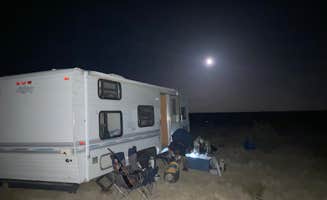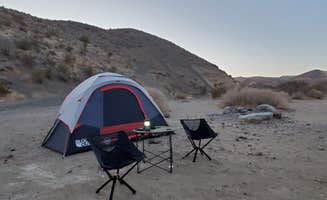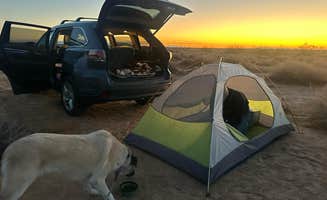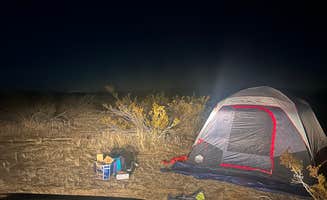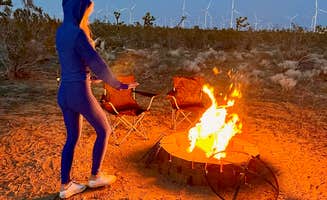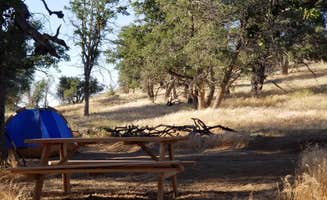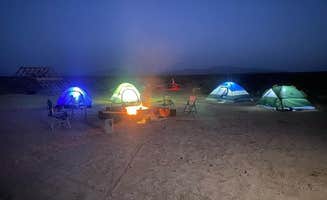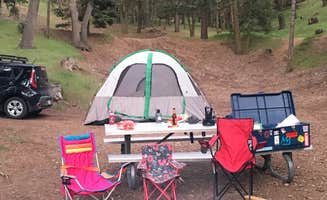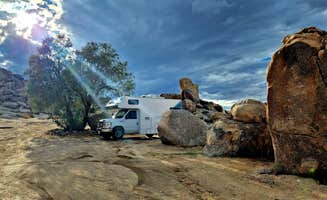Dispersed camping sites surrounding California City, California sit between 2,000-4,000 feet elevation in the western Mojave Desert. This arid region transitions from creosote flats to Joshua tree woodlands, creating distinct camping environments depending on your elevation. Winter temperatures frequently drop below freezing at night, requiring adequate cold-weather gear even when daytime highs reach comfortable ranges.
What to do
Stargazing after dark: The desert skies near California City provide exceptional visibility for astronomical observation. At Dove Springs OHV Area, campers report excellent conditions for night sky viewing. "T-Mobile signal was good enough to watch hd video," notes one reviewer, though they caution about wind conditions that "felt like I was on a boat" during their stay.
Sunrise photography: Early risers benefit from dramatic lighting conditions across the desert landscape. At BLM Desert Site, one visitor shared, "I wasn't sure when driving out here at night in a minivan, but the dirt road didn't give me any trouble and I still had some service with Verizon. It's a great little secluded spot about 4 miles off the highway in the desert. I missed the sunset but caught a beautiful sunrise."
Weekday camping: For quieter experiences away from OHV traffic, schedule mid-week stays. According to a camper at Jawbone Canyon OHV Area, "Weekends are busy but weekdays are exceptionally peaceful. Be advised the Jawbone canyon store charges RV's $40.00 for potable water. Fill up before you come out here."
What campers like
Desert solitude: Many campsites near California City offer significant privacy and isolation. At East Mojave Camp, campers appreciate the remoteness: "Very remote absolutely nothing out there. Definitely somewhere you need to be aware of your surroundings. You can get far enough away from the highway that you don't need to worry about people driving by."
Geological formations: The desert landscape features distinctive rock formations that enhance the camping experience. At Ricardo Campground, one visitor noted, "Stunning sites in pocket canyon with soaring rock formations abutting camping area. Staffed midday only due to COVID. Primitive bathrooms and no showers or running water. Quiet and simple."
Site positioning: Strategic site selection can significantly improve comfort in this harsh environment. One camper at Ricardo Campground observed, "The sites up by the cliffs are offer the best views but many may be difficult to get level in if you have a motorhome or travel trailer."
What you should know
Extreme wind conditions: High winds represent a consistent challenge throughout the region. A visitor at Jawbone Canyon OHV Area reported simply, "Plenty of spots right off the road. I drove in after dark and needed a place to sleep before I hit Death Valley. The wind was absolutely howling, but not too bad."
Limited facilities: Most dispersed camping areas lack basic amenities. Bring all necessary supplies, including water. At Borax Bill Substation, campers noted, "Office is only open th-tue, but staff roaming the area are very helpful. Dry camp the other days anywhere you want. Need tokens for showers, which you can get when office is open."
Road access challenges: Many camping areas require careful navigation of unmaintained roads. A camper at East Mojave Camp warned, "The road to it is unmarked and very unmaintained. Would definitely recommend high clearance vehicle if you want to be further away then 100 feet from the highway. Lots of wash outs."
Tips for camping with families
Site selection for temperature management: Choose sites with natural shade features when possible. At Ricardo Campground, a camper shared, "The views from this campground are absolute stellar. The sites and pit toilets are clean and plenty of spaces were available. It was all first come, first served and self-pay when we arrived."
Seasonal timing: Plan family trips during moderate seasons (fall/spring). Summer temperatures regularly exceed 100°F, making camping dangerous without proper preparation. One camper at Ricardo Campground mentioned, "The desert was alive in April! I got #8 which had a nice view. Not too crowded at 1 pm on a Saturday where I got to choose from a dozen open sites."
Site accessibility: For families with standard vehicles, stick to main campground roads rather than remote dispersed sites. At Spaceport RV Park, one visitor observed, "Spots are on gravel or a concrete pad with plenty of room to maneuver, and while some are right next to each other, when we were there there was plenty enough open spaces to not have to cram in."
Tips from RVers
Dump station access: Plan water and waste management carefully when boondocking. At Spaceport RV Park, one RVer noted, "It's my understanding they let you dump for $5.00 and fill your freshwater tank for $2.00 even if you don't stay here."
Site leveling challenges: Many natural camping areas require leveling equipment. At Ricardo Campground, a visitor mentioned, "Nice views backing up to scenic rock cliffs. Clean pit toilets. Most sights have a little slope... used a few leveling blocks. Quiet... First come... first served... Compacted dirt gravel road in good condition."
Wind positioning: In high-wind conditions, position RVs strategically. One camper at Dove Springs OHV Area shared, "had to park my class C facing the wind to minimize swaying, but at times it felt like I was on a boat."


